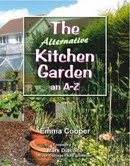Book Review: The Alternative Kitchen Garden
Cooper is based in the UK, which means that most of her advice is geared toward those gardening there, but I still found plenty to pique my interest. The book is now, of course, littered with notes not just for this review, but for my garden, too. I daresay, as well, that the next time we venture to that other island I’ll be visiting some of the places she mentions in the book – the RISC Roof Garden springs to mind as does Garden Organic’s demonstration gardens in Ryton – and I’ve already begun trying to persuade friends there to join the latter’s seed library.
What I really liked best about the book, though, is Cooper’s way of telling what’s happening inside the plant or under the surface of the soil. As an organic gardener and farm-assistant, I’m curious to know these things. I don’t rely on chemical pesticides or fertilizers at all, and so I need to know how to best create an environment that my plants can grow in. It means feeding the soil, inviting wildlife, and monitoring for pests and disease. Advice such as “Build your wildlife from the ground up.” (pg. 37) reminds me that my garden is really a whole swirling mass of living beings of which the vegetables are perhaps just the most conspicuous. I need the whole suite of companions to make it really amazing.
Cooper’s explanations are delivered in a chatty manner that could (but does not) detract from the quality of the information offered. Stories of her own misadventures, discoveries, and successes form the foundation of the information here, which gives it a ‘truthiness’ that is appealing. Clearly, she’s an expert in her field, but like me she’s continuing to learn and her willingness to share the resulting knowledge makes this book feel like a useful reference as well as an “over the fence conversation.” Chapters with titles such as Happiness and Years could come off as syrupy and sentimental, but instead strike a chord with gardeners everywhere: “Seeing the sparrows swooping onto the patio to feed among my containers makes me smile,and so does the blackbird – although he digs through the soil and makes more of a mess!” (pg. 121)
While sometimes limited by the amount of space available (two pages for each letter of the alphabet) the book offers a goodly amount of information without being overwhelming. The chapter on tubers, for example, contains a nice bit of technical language that kept me on my toes, but also glued to the page. I had no idea tubers were “plant storage organs…that keep plants alive when they’re dormant and allow them to burst into life and grow leaves” that are really “modified plant stems.” (pg. 296) It sounds logical now, but who would have thought? Similarly, while I had a basic knowledge of why hardening off plants helps ensure their success I did not know exactly what was happening inside the plant. And the chapter on xanthopyll offered paragraph after paragraph of solid information on sources of leaf discoloration with some good advice for amelioration, too.
I also quite liked the creative connections Cooper makes to things that at first glance might be considered non-gardening (hence the title, I suppose) such as Zero Waste, Freecycle, Footprints, Climate Change, and Osteopath. Some, like Freecycle, are good ways to cheaply find supplies, meet neighbors and reduce the carbon footprint of the garden itself. Climate Change advises gardeners to “…save your own seeds so that your vegetables adapt to your local conditions” as well as to “…make your garden wildlife friendly so that you have a robust garden ecosystem that has the best chance of adapting to changing conditions.” (pg. 53) Others, such as Osteopath, offer advice to ensure the ability to continue gardening in a healthy manner.
Perhaps the only downside to The Alternative Kitchen Garden is the self-imposed brevity of the explanations. A good chunk of one of the allotted two pages is taken up by a photograph, which while lovely (U is perhaps my favorite) might be better smaller to allow more room for writing. There were moments (xanthophyll and mulch, for example) where things felt a bit rushed or awkwardly stretched (marigolds, perhaps) to accommodate the space. These were rare moments, though, and didn’t detract from my overall enjoyment and learning.
As a gardener, I like a challenge. (I wouldn’t be out there in all weather if I didn’t.) New vocabulary, new ideas, new techniques, etc., is what I’m hoping for when I open a gardening book and often what I need now and again, too. Offering these things to gardeners at all stages of experience, in a variety of sizes, types, and locations is the challenge of a broad-themed book like this one, but one that The Alternative Kitchen Garden meets admirably.
The Alternative Kitchen Garden: An A-Z
by Emma Cooper
376 pages
Joan Bailey
https://popcornhomestead.blogspot.com/




 Your Privacy Choices
Your Privacy Choices
Leave a comment